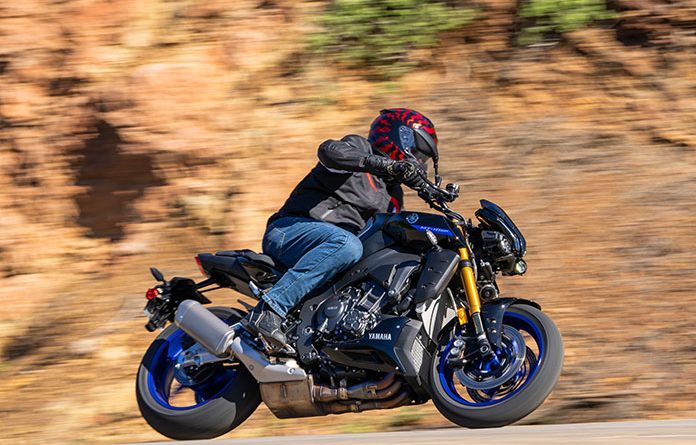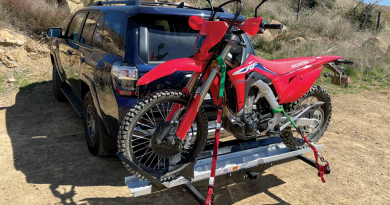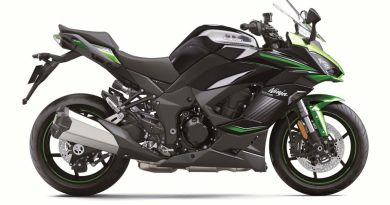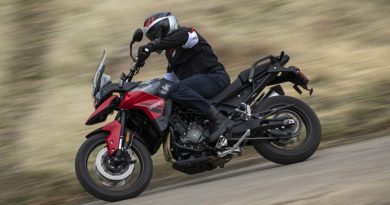2023 Yamaha MT-10 SP | First Ride Review
Gracing the cover of Rider’s October 2022 issue was the Yamaha MT-10, a thrilling naked sportbike based on the YZF-R1. I had the privilege of riding the MT-10 at the press launch in North Carolina, and afterward, Yamaha loaned us an accessorized version for further testing (we’ll have a report in a future issue).
Related: 2022 Yamaha MT-10 | Video Review
Yamaha also offers an up-spec version called the MT-10 SP. Priced at $17,199 – a $3,000 premium over the standard model – the SP features Öhlins semi-active suspension, steel-braided front brake lines, a polished aluminum swingarm, a YZF-R1M-inspired Liquid Metal/Raven colorway with blue wheels, and a color-matched lower fairing.
The Yamaha MT-10 SP Goes for the Gold
The MT-10 SP is the first production motorcycle to be equipped with the Öhlins NIX30-SV fork and TTX36-SV rear shock. The “SV” stands for “spool valve,” a new damping technology that Öhlins claims improves rider comfort – not typically something high-performance sportbikes are known for.
According to the Swedish makers of those coveted yellow and gold suspension components, “unlike a traditional needle valve, Öhlins’ spool valve features a pressure compensation chamber that balances the force applied to the damper’s actuator, enabling quicker adjustment. The spool valve also provides increased sensitivity and responsiveness at the low and high ends of the adjustment range.”
Öhlins’ NIX30 fork and TTX36 shock are primo suspenders that were developed in the heat of World Superbike and Supersport competition. The semi-active versions on the MT-10 SP use inputs from sensors and a 6-axis IMU to electronically manage rebound and compression damping. Through the Yamaha Ride Control menu, riders can choose between three semi-active damping modes (A-1, A-2, and A-3) and three manual setting modes (M-1, M-2, and M-3).
GEAR UP
HELMET: Fly Racing Sentinel
JACKET: Fly Racing Butane
GLOVES: Fly Racing FL-2
PANTS: Fly Racing Resistance Jeans
BOOTS: Fly Racing Milepost
Damping in the semi-active modes progresses from sporty/firm in A-1 (ideal for track riding) to mildly sporty in A-2 (good for public roads) to comfortable in A-3 (for when you’re loaded up with soft luggage and need to burn miles on a weekend tour). Should a rider feel so inclined, the “automatic” modes can be fine-tuned to suit one’s preferences. Though labeled in ascending order as well, the manual modes are customizable, allowing riders to electronically tune rebound and compression damping independently and save those settings. Preload front and rear must be adjusted manually.
Whereas many electronic rider aids like ABS, traction control, and wheelie control are essentially safety nets that work in the background to increase a rider’s margin of error, electronically controlled suspension truly enhances the overall riding experience. As good as the manually adjustable “analog” KYB suspension is on the standard MT-10, there is no ideal set of preload, rebound, and compression settings that adequately cover the range of riding and road conditions a rider is likely to encounter. The SP’s network of sensors and actuators adjust damping almost instantly – firming up the fork under hard braking to prevent excessive dive, stiffening the rear shock under hard acceleration to prevent squat, and compensating for changes in speed, lean angle, and so on.
At the test ride on the MT-10 SP was the usual gaggle of fast guys on curvy roads, with me doing my best to keep up while also trying to coax my ever-expanding beard up inside my helmet’s chinbar so I didn’t look like a billygoat. We started off at the Petersen Automotive Museum in Los Angeles and made our way along beat-up, traffic-clogged surface streets and poured-concrete freeways to the Pacific Coast Highway and then up into the Malibu hills on roads of varying quality and camber.
The “middle ground” A-2 semi-active mode is the SP’s default suspension setting, and as one might expect, it was firm without being too stiff. It absorbed the concrete seams on the freeway and the unavoidable recessed manhole covers on the PCH without undue harshness. The bike must be stopped before suspension settings can be changed, so at a stoplight, I switched to the sportier A-1 mode before the long, mostly smooth climb up Kanan Dume Road. All was well until I hit a big dip in the pavement at speed, which was a little too jarring for my taste.
After turning onto the notoriously tight, twisty, and – especially after a recent rainstorm – dirty Latigo Canyon Road, our group pulled over after our ride leader’s walkie-talkie fell out of his pocket. I switched back to A-2 mode and attacked the familiar corners with gusto while enjoying an upswell of confidence. Part of what makes semi-active suspension such a game changer in terms of both speed and safety is its ability to keep a motorcycle chassis stable and he tires’ contact patches in contact with the pavement.
After lunch, tumescent with too many tortilla chips and shrimp tacos, I switched over to A-3 mode and enjoyed a softer ride for our return to the Petersen. Burp.
See all of Rider‘s Yamaha coverage here.
Fast is as Fast Does
Except for the Öhlins semi-active suspension and steel-braided front brake lines, the latter providing better feel at the lever since the hoses can’t expand under pressure like rubber lines, the MT-10 SP is mechanically the same as the standard model. Which is to say, it’s one helluva motorcycle. The upgraded suspension pairs nicely with the MT-10 SP’s rock-solid chassis, strong brakes, and grippy tires, making for a potent, satisfying combination.
Our First Ride Review goes into more detail about updates to the MT-10 platform for 2022. In a nutshell, its 998cc inline-Four’s fuel injection, intake, and exhaust systems were revised to enhance the engine’s torque character, and new Acoustic Amplifier Grilles atop the fuel tank transmit tuned induction sound to the rider. Yamaha’s Accelerator Position Sensor Grip gives the throttle-by-wire system a more natural feel, and a new 6-axis IMU informs a full suite of YZF-R1-derived electronic aids, including lean-sensitive traction control, slide control, wheelie control, engine brake management, and cornering ABS. Other changes include a one-tooth-smaller rear sprocket, an up/down quickshifter, Brembo brake master cylinders, Bridgestone S22 tires, a 4.2-inch color TFT display, revised ergonomics, and stripped-down styling with full LED lighting.
Without a doubt, the star of the MT-10 show is its CP4 crossplane-crank engine. Rather than the high-pitched whine of a typical inline-Four, the CP4’s uneven firing interval results in a deep growl more like a V-4. Fueling and throttle response are spot-on. The engine feels a tad dull below 4,000 rpm, but it builds up a good head of steam in the midrange and goes gangbusters above 8,000 rpm. This is one of those engines that not only produces impressive power (138 hp at the rear wheel on an MT-10 we dyno’d a few years ago), but also delivers an engaging, visceral experience, encouraging one to roll on and off the throttle repeatedly to savor the full range of its sound and fury.
Through the menus on the TFT display, the Yamaha Ride Control system allows riders to select among four different ride modes (A, B, C, and D) to adjust throttle response and all the other electronic rider aids. Each mode has presets, but everything is customizable. Sifting through the various options and combinations of settings can be a little overwhelming, and Yamaha’s switchgear and menu system isn’t as user-friendly as what’s available on some other bikes we’ve tested, but most owners will find their preferred settings and stick to them. For me, that was suspension mode A-2, power mode 2 (standard), engine braking mode 2 (reduced), brake control mode 2 (lean-sensitive), and middle of the road settings for traction control, slide control, and wheelie control.
With the customization that the Yamaha Ride Control allows, riders can specify different personalities for the SP: hard-charging track weapon, surgical canyon carver, weekend sport-tourer, or daily commuter. Yamaha’s factory accessories for the MT-10 also fit the SP, so riders can further personalize their bike with frame and axle sliders, a Yoshimura slip-on exhaust, a windscreen, a comfort seat, 30L or 50L top cases, soft side cases, and more.
Special Sauce
If you’ve got your eye on the MT-10 and the SP model is within reach, the Öhlins semi-active suspension is worth the upcharge alone. The only downside is that it adds 5 lb to the bike’s curb weight compared to the standard model. The steel-braided front brake lines, polished swingarm, lower cowl, and exclusive paint job are nice bonuses, leveling up the MT-10 SP into a truly special machine. Or, in the words of G. Love & Special Sauce, a Philadelphia band I listened to in my college days: My baby got sauce, Your baby ain’t sweet like mine.
2023 Yamaha MT-10 SP Specs
Base Price: $17,199
Website: YamahaMotorsports.com
Warranty: 1 yr., unltd. miles
Engine Type: Liquid-cooled, transverse inline-Four, DOHC w/ 4 valves per cyl.
Displacement: 998cc
Bore x Stroke: 79.0 x 50.9mm
Horsepower: 138 hp at 9,400 rpm (rear-wheel dyno, previous model)
Torque: 77 lb-ft at 9,200 rpm (rear-wheel dyno, previous model)
Transmission: 6-speed, cable-actuated slip/assist wet clutch
Final Drive: Chain
Wheelbase: 55.3 in.
Rake/Trail: 24 degrees/4.0 in.
Seat Height: 32.9 in.
Wet Weight: 472 lb
Fuel Capacity: 4.5 gal
Fuel Consumption: 36 mpg (claimed)
The post 2023 Yamaha MT-10 SP | First Ride Review first appeared on Rider Magazine.




